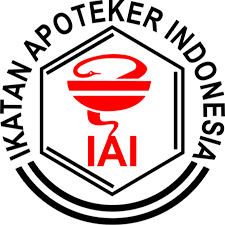Formulasi Gel Antibakteri Ekstrak Daun Pandan Wangi (Pandanus amaryllifolius Roxb.) Menggunakan Hydroxy Propyl Methyl Cellulose(HPMC) dan Uji Aktivitas terhadap Staphylococcus aureus
Febriana Eka Valentina(1*), Dwi Saryanti(2)(1) Program Studi DIII Farmasi, Sekolah Tinggi Ilmu Kesehatan Nasional
(2) Program Studi DIII Farmasi, Sekolah Tinggi Ilmu Kesehatan Nasional
(*) Corresponding Author
Abstract
The content of flavonoids, alkaloids, and saponins in fragrant pandan leaves (Pandanus amaryllifolius Roxb.) can be antibacterial to inhibit the growth of microorganisms on the skin. The extract obtained from fragrant pandan leaves (DPW) is processed into a gel, with the consideration that the gel adheres well, does not block skin pores, is easily rinsed with water and has very good absorption. The purpose of this study was to determine the HPMC content as a gelling agent so as to obtain an antibacterial gel preparation of DPW extract with the best physical quality and antibacterial activity on Staphylococcus aureus (SA). The DPW ethanol 96% extract gel made from 2%, 3%, 4% HPMC was tested for the physical stability of the gel stored at room temperature for 21 days which included evaluation of organoleptic, homogeneity, degree of acidity, viscosity, spreadability, adhesion. Gel activity against SA was carried out using the well method. Antibacterial gel from DPW extract using 2% HPMC concentration has the best physical quality compared to DPW extract gel with other HPMC concentrations. Antibacterial gel from DPW extract with 2% HPMC concentration in gel form, dark green color, pandan aroma, homogeneous and uniform, pH 6 ± 0, pH is not harmful to skin, viscosity 325 ± 0 dPa.s, spreadability 7.5 gcm /s , adhesion 15.17 ± 0.00 seconds, antibacterial activity against SA with an inhibition zone of 27.26 ± 25.30 mm was classified as very strong. The result of preparations were stable for 21 days.
Keywords
Full Text:
PDFReferences
Afianti, H. P., & Murrukmihadi, M. 2015. Pengaruh Variasi Kadar Gelling Agent HPMC Terhadap Sifat Fisik Dan Aktivitas Antibakteri Sediaan Gel Ekstrak Etanolik Daun Kemangi (Ocimum basilicum L. forma citratum Back.). Majalah Farmaseutik, 11(2) p.307-315
Aisyah. 2015. Daya Hambat Ekstrak Pandan Wangi (Pandanus Amaryllifolius Roxb.) Terhadap Pertumbuhan Bakteri Staphylococcus aureus. Skripsi, Fakultas Kedokteran Gigi Universitas Hasanuddin.
Astuti, R. D., & Utami, A. R. 2021. Formulasi Dan Evaluasi Sediaan Gel Ekstrak Metanol Kulit Buah Pisang Raja ( Musa X Paradisiaca AAB) Dengan Variasi HPMC Sebagai Gelling Agent. Jurnal Kesehatan Pharmasi (JKPharm), 3(2), p. 89-98
Dasopang, & Sartika, E. 2016. Formulasi Sediaan Gel Antiseptik Tangan Dan Uji Aktivitas Antibakteri Dari Ekstrak Etanol Daun Pandan Wangi (Pandanus amaryllifolius Roxb.). Biolink (Jurnal Biologi Lingkungan Industri Kesehatan), 3(1), 81-91
Faras, A. F., Wadkar, S. S., & Ghost, J. S. 2014. Effect of Leaf Extract of Pandanus amaryllifolius Roxb on Growth of Escherichia coli and Micrococcus (Staphylococcus) aureus. International Food Research Journal, 21(1), 421–423.
Gupta, G. D., Loveleen, P. K., & Rajeev, G. 2010. Development And Evaluation Of Topical Gel Of Minoxidil From Different Polymer Bases In Application Of Alopecia. International Journal of Pharmacy and Pharmaceutical Sciences, 2(3), 43–47.
Kibbe, A. , H. 2004. Handbook of Pharmaceutical Excipients (3rd ed.). Pharmaceutical Press, London.
Marselia, S., Wibowo, M. A., & Arreneuz, S. 2015. Aktivitas Antibakteri Ekstrak Daun Soma (Ploiarium alternifolium Melch) terhadap Propionibacterium acne. Jurnal Kimia Khatulistiwa, 4(4), 72-82
Nursiah, H., Faradiba, & Baharuddin, G. A. 2011. Formulasi gel sari buah belimbing wuluh (Averrhoa bilimbi L.). Majalah Farmasi Dan Farmakologi, 15(1), 5–9.
Oxoid. 2006. Manual Oxoid. Oxoid Limited: Bandung.
Robinson. T. 1995. Kandungan Organik Tumbuhan Tingkat Tinggi. Insitut Teknologi Bandung, Bandung.
Rowe, R. C., Paul J.S., & Marian. 2009. Hand book of pharmaceutical excipient (6th ed.). USA:Pharmaceuticals Press and The American Pharmacist Association.
Sabir, A. 2005. Aktivitas antibakteri flavonoid propolis Trigono sp terhadap bakteri Streptococcus mutans (in vitro). Majalah Kedokteran Gigi, 38(5), 135.
Sinko, P. J. 2012. Martin Farmasi Fisika dan Ilmu Farmasetika (Joshita D dan Amalia H, Ed.; 5th ed.). EGC, Jakarta.
Slamet, S., Anggun, B. B., & Pambudi D.B. 2020. Uji Stabilitas Fisik Formula Sediaan Gel Ekstrak Daun Kelor (Moringa oleifera Lamk.). Jurnal Ilmiah Kesehatan , 13(2), 115-122
Suardi, M., Armenia, & Maryawati, A. 2008. Formulasi dan Uji Klinik Gel Antijerawat Benzoil Peroksida-HPMC. Laporan Penelitian: Fakultas Farmasi Universitas Andalas, Sumatra Barat.
Sukandar, D., Hermanto, S., & Lestari, E. 2008. Uji Toksisitas Ekstrak Daun Pandan Wangi (Pandanus amaryllifolius Roxb.) Dengan Metode Brine Shrimp Lethality Test (BSLT). Jurnal Kimia, 1(2), 63-70
Sulaiman, T. N. S., & Suryani, T. 2018. Formulasi Gel Minyak Atsiri Sereh Dengan Basis HPMC Dan Karbopol. Majalah Farmasetik, 14(2), 87–95.
Tong, S. Y. C., Davis, J. S., Eichenberger, E., Holland, T. L., & Fowler, V. G. 2015. Staphylococcus aureus Infections: Epidemiology, Pathophysiology, Clinical Manifestations, And Management. Clin Microbiol Rev, 28(3) p. 603-661
Voigt, R. 1995. Buku Pelajaran Teknologi Farmasi (S. Noerono, Ed.; 5th ed.). Gadjah Mada University Press, Yogyakarta.
Wikananda, I. D. A. R. N., Hendrayana, M. A., & Pinatih, K. J. P. 2019. Efek Antibakteri Ekstrak Ethanol Kulit Batang Tanaman Cempaka Kuning (M. Champaca L.) Terhadap Pertumbuhan Staphylococcus aureus. E Jurnal Medika Udayana, 8(5).
Article Metrics
Abstract view(s): 1608 time(s)PDF: 2340 time(s)
Refbacks
- There are currently no refbacks.








